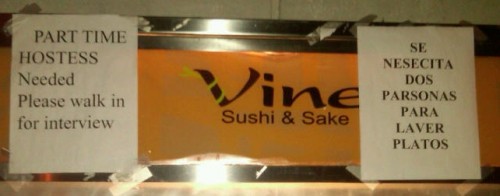Jake C. sent in a good example of the racialization and gendering of jobs within the service industry. This photo shows two notices for openings at a restaurant, one in English, one in (misspelled) Spanish:
The notice in Spanish isn’t a translation of the one about the hostess job; rather, it announces that two people are needed as dishwashers. It shows the way that particular positions within a workplace are often associated with certain groups, and how organizational policies may reinforce occupational segregation by sex or race/ethnicity. The role of greeting and seating customers is explicitly gendered as a hostess, while the language difference will channel applicants into different jobs. These types of practices are one part of the process that channels individuals into different positions in the workplace, both by restricting access to information about jobs and providing subtle messages to potential applicants about which positions are the best fit for them.


Comments 33
Guest — December 6, 2011
On the other hand, if you can't read English well enough to understand that sign, you probably also can't speak English well enough to communicate with the majority of patrons who would go to a sushi restaurant.
(Sorry to be the devil's advocate. I actually agree that gendering and racializing occupations is very real and important issue in this country- especially when it comes to the wages different occupations receive.)
Seth Eag — December 6, 2011
Yes, for several years I worked in a restaurant in New York. It was always an unwritten rule that you didn't hire males to work the front door. But with the Spanish sign this may just be a reflection of reality (although you could make a chicken/egg argument), you see dishwashers make so little, work so hard, and under such horrible conditions that generally the only people that take the jobs are undocumented workers who have no other choice—this is true in even the fancier uptown restaurants.
Anonymous — December 6, 2011
It may seem like a somewhat odd point, but the font of the two signs differ as well. The Spanish sign seems like it was rushed without much care, all in capital letters and possibly in bold whereas the hostess sign has a mix of upper and lower case and varied letters. This seems to me to speak volumes too about the people they are hoping to attract to the jobs.
hopeless shade — December 6, 2011
The Spanish sign was definitely rushed, no doubt; they didn't bother to find someone who could spell more than every other word correctly, for one.
But they're both Times New Roman, and honestly, the Spanish one is definitely more put together--all caps, all centered, all bolded--than the English--the first sentence is half all caps, half capitalized, and 'part time' is right-aligned versus the left-aligned entire rest of the sign. That disjointed "Needed" that doesn't look like it's supposed to be part of "part time hostess" definitely threw me off as much as the "parsonas."
betsy santos — December 6, 2011
That "Spanish". Geez.
Estella — December 6, 2011
Wait, "subtle" messages? I think this is pretty blatant.
synco — December 7, 2011
That sign isn't even the worst atrocity committed by this restaurant. The owner is notorious for underpaying his workers at all of his restaurants to the point where they have held several strikes. If you are in NYC, please do not eat here or at Saigon Grill or any other associated restaurants: http://boycottsaigongrill.blogspot.com/2011/03/victories-throughout-upper-west-side.html
Sushux — December 8, 2011
I like that the sign is from a Sushi restaurant. A lot of Asian restaurants here have the whole "Asian in the front, Hispanic in the back" situation -- maybe because the Asian hostess conveys a sense of "authenticity" through self-orientalism ... I find it particularly amusing because one of my favorite Japanese restaurants is run by Koreans, staffed by Chinese, and the kitchen is staffed by Latinos. One of my favorite Pearl Milk Tea places has froofy c-pop blasting in the front, and Mexican accordion music blasting in the back. I'd prefer to think it's willful collusion to sell middle-class Americans the idea of Asian cuisine.
(Just like how calling ikazaya food "Japanese Tapas" allows you to charge 3x the price than if you called it "Japanese Dim Sum")
laddiebuck — December 8, 2011
As others have pointed out, if you can't read the sign in English, you've no business greeting customers, so it makes no sense for that to have to be translated.
The flip side is equally easy to explain. The kitchen staff is probably mostly Spanish-speaking and they'd rather hire more staff who speak Spanish than folks who don't.
Please don't trivialise your cause by tilting at windmills, thanks.
apple — December 14, 2011
where's the one in Japanese for a sushi chef?